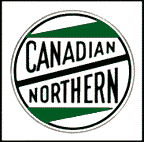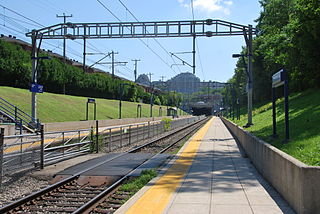
The Grand Trunk Railway was a railway system that operated in the Canadian provinces of Quebec and Ontario and in the American states of Connecticut, Maine, Michigan, Massachusetts, New Hampshire, and Vermont. The railway was operated from headquarters in Montreal, Quebec, with corporate headquarters in London, United Kingdom. It cost an estimated $160 million to build. The Grand Trunk, its subsidiaries, and the Canadian Government Railways were precursors of today's Canadian National Railway.

The Canadian Northern Railway (CNoR) was a historic Canadian transcontinental railway. At its 1923 merger into the Canadian National Railway, the CNoR owned a main line between Quebec City and Vancouver via Ottawa, Winnipeg, and Edmonton.
The National Transcontinental Railway (NTR) was a historic railway between Winnipeg and Moncton in Canada. Much of the line is now operated by the Canadian National Railway.

The Grand Trunk Western Railroad Company is an American subsidiary of the Canadian National Railway operating in Michigan, Illinois, Indiana, and Ohio. Since a corporate restructuring in 1971, the railroad has been under CN's subsidiary holding company, the Grand Trunk Corporation. Grand Trunk Western's routes are part of CN's Michigan Division. Its primary mainline between Chicago and Port Huron, Michigan serves as a connection between railroad interchanges in Chicago and rail lines in eastern Canada and the Northeastern United States. The railroad's extensive trackage in Detroit and across southern Michigan has made it an essential link for the automotive industry as a hauler of parts and automobiles from manufacturing plants.

The Mount Royal Tunnel is a railway tunnel in Montreal, Quebec, Canada. The tunnel is the third longest in Canada, after the Mount Macdonald Tunnel and the Connaught Tunnel, and connects the city's Central Station, in Downtown Montreal, with the north side of Montreal Island and Laval and passes through Mount Royal.

Gananoque railway station in Gananoque, Ontario, Canada is served by Via Rail trains running from Toronto to Ottawa and Montreal. The station is an unstaffed but heated shelter.

The Kingston railway station is an inter-city passenger rail station in Cataraqui, Kingston, Ontario, Canada. It is served by Via Rail trains running from Toronto to Ottawa or Montreal, along the Corridor route. It is located on John Counter Boulevard, northeast of Princess Street and north-west of downtown Kingston.

Napanee railway station in Napanee, Ontario, Canada is served by Via Rail trains running from Toronto to Ottawa and Montreal. The 1856 limestone railway station is an unstaffed but heated shelter with telephones and washrooms, which opens at least half an hour before a train arrives. The shelter and platform are wheelchair-accessible.

The Belleville railway station in Belleville, Ontario, Canada is served by Via Rail trains running from Toronto to Ottawa and Montreal. The station is staffed, with ticket sales, vending machines, telephones, washrooms, and wheelchair access to the station and trains.

Port Hope railway station in Port Hope, Ontario, Canada, is one of the oldest Canadian passenger rail stations still in active use. Served by Via Rail trains running from Toronto to Kingston and Ottawa, it was also a stop for trains to and from Montreal until January 24, 2012. The station is unstaffed, but has a heated waiting room, pay telephone, washrooms, free outdoor parking, and wheelchair access.
The Canada Atlantic Railway Company (CAR) was a historic North American railway located in Ontario, southwestern Quebec and northern Vermont. It connected Georgian Bay on Lake Huron with the northern end of Lake Champlain via Ottawa. It was formed in 1897 through a merger of three separate railway companies that John Rudolphus Booth had either purchased or created, beginning in 1879. The CAR was owned by Booth for eight years after its formation until he sold it to the Grand Trunk Railway (GTR) in 1904.

The Thousand Islands Railway was an 8 km (5.0 mi) long railway running from the town of Gananoque north to the Grand Trunk Railway Toronto-Montreal mainline, just south of present-day Cheeseborough. The service ran for 111 years between 1884 and 1995. The rails were removed in October 1997.

Canadian National Railway's Kingston Subdivision, or Kingston Sub for short, is a major railway line connecting Toronto with Montreal that carries the majority of CN traffic between these points. The line was originally the main trunk for the Grand Trunk Railway between these cities, although there has been some realignment of the route between these cities. The majority of the Kingston Sub runs close to the northern bank of Lake Ontario and the Saint Lawrence River.

The Central Ontario Railway (COR) was a former railway that ran north from Trenton, Ontario to service a number of towns, mines, and sawmills. Originally formed as the Prince Edward County Railway in 1879, it ran between Picton and Trenton, where it connected with the Grand Trunk Railway that ran between Montreal and Toronto. After being purchased by a group of investors and receiving a new charter to build northward, the company was renamed the Central Ontario Railway in 1882, and it started building towards the gold fields at Eldorado and newly discovered iron fields in Coe Hill.
The Belleville and North Hastings Railway (B&NHR) was a short-line railway in Hastings County, Ontario, Canada. It branched off the Grand Junction Railway (GJR) north of Belleville and ended on the Central Ontario Railway (COR) outside Eldorado for a total distance of 33 kilometres (21 mi). In spite of its name, the line did not reach either Belleville or the northern part of Hastings County.

The Railway Museum of Eastern Ontario, a rail museum in a former CNoR station, stands on the abandoned right-of-way of a Canadian Northern Railway line which once led southwest toward Napanee. Established 1985 as the Smiths Falls Railway Museum, the RMEO works to preserve the 1913 Canadian Northern (CNoR) station and a collection of historic rolling stock, equipment and railway memorabilia.

The Bay of Quinte Railway is a former short line railway in eastern Ontario, Canada. It was formed as the Napanee, Tamworth and Quebec Railway (NT&QR), chartered in 1878 by Edward Rathbun and Alexander Campbell, with plans to run from Napanee through Renfrew County and on to the Ottawa Valley. Lacking funding from the governments, development never began.

The Lake Simcoe Junction Railway (LSJR) was a short-line narrow gauge railway in Ontario just north of Toronto. It branched off the Toronto and Nipissing Railway at Stouffville and ran 42 kilometres (26 mi) north to the town of Sutton and then beyond to the shore of Lake Simcoe where a large wharf was built. The presence of the railway helped the town of Jackson's Point form on the lakeside. The line serviced timber and agricultural shipping, but was more widely used for shipping ice cut from the lake in the winter, and allowing weekend day trips to the lake in the summer.

The Canadian National Railway Bala Subdivision is a major railway service line in Ontario running between the provincial capital of Toronto in Southern Ontario and Capreol in Northern Ontario, where the line continues as the Ruel Subdivision. It forms part of CN's transcontinental mainline between Southern Ontario and Western Canada.

The Waterloo Junction Railway (WJR) is a short line railway in the Region of Waterloo, Ontario, Canada. It runs northward from the former Grand Trunk Railway (GTR) North Main Line in downtown Kitchener, through Waterloo and St. Jacobs before terminating in Elmira. It is currently owned by the City of Waterloo and operated by CN as the Waterloo Spur. The Waterloo Central Railway runs tourist trains on the line, and the Ion rapid transit runs on the route for a short distance.


















